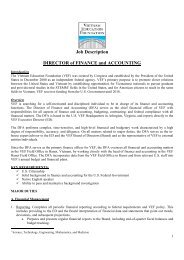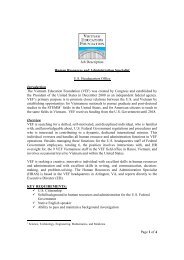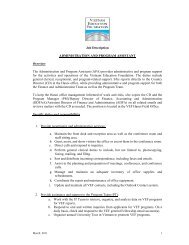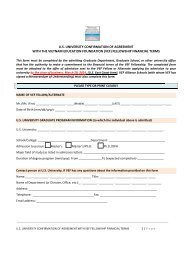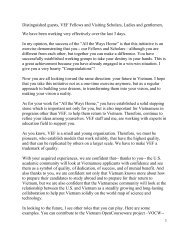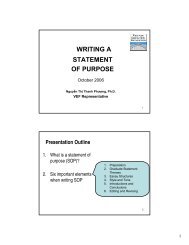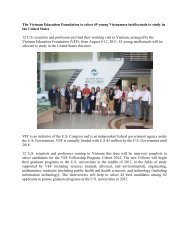The Vietnam Education Foundation 2011 Annual Report
The Vietnam Education Foundation 2011 Annual Report
The Vietnam Education Foundation 2011 Annual Report
Create successful ePaper yourself
Turn your PDF publications into a flip-book with our unique Google optimized e-Paper software.
<strong>Annual</strong> <strong>Report</strong> <strong>2011</strong> Page 73<br />
<strong>Vietnam</strong> <strong>Education</strong> <strong>Foundation</strong><br />
Notes to Financial Statements<br />
September 30, <strong>2011</strong> and 2010<br />
NOTE 1 – SIGNIFICANT ACCOUNTING POLICIES (CONTINUED)<br />
Property and Equipment (continued)<br />
Useful lives are as follows:<br />
Equipment -<br />
Furniture -<br />
4 years<br />
4 years<br />
Maintenance, repairs and minor renovations are expensed as incurred. Expenditures that materially increase values,<br />
change capacities or extend useful lives will be capitalized.<br />
<strong>The</strong> costs of any leasehold improvements financed with VEF appropriated funds will be capitalized if the total cost<br />
exceeds $25,000. Construction costs will be accumulated as “construction in-progress” until completion and then<br />
transferred and capitalized as a “leasehold improvements” over 7 years or the remainder of the lease, whichever is<br />
less.<br />
Internal use software development and acquisition costs of $25,000 will be capitalized as “software development-inprogress”<br />
until the development stage is completed and the software is successfully tested. At acceptance, “software<br />
development-in-progress” costs are reclassified as “internal use software” and amortized using the straight-line<br />
method over an estimated useful life of 4 years. Purchased commercial software that does not meet the capitalization<br />
criteria will be expensed. Enhancements that do not add significant new capability or functionality will be expensed.<br />
Prepaid and Deferred Charges<br />
Payments in advance of the receipt of goods and services are recorded as prepaid charges at the time of prepayment<br />
and recognized as expenses when the related goods and services are received.<br />
Liabilities<br />
Liabilities represent amounts expected to be paid as the result of a transaction or event that has already occurred.<br />
Liabilities covered by budgetary resources are liabilities incurred which are covered by realized budgetary resources<br />
as of the balance sheet date. Available budgetary resources include new budget authority, spending authority from the<br />
offsetting collections, recoveries of unexpired budget authority through downward adjustments of prior year<br />
obligations, unobligated balances of budgetary resources at the beginning of the year. Unfunded liabilities are not<br />
considered to be covered by such budgetary resources. Examples of unfunded liabilities are actuarial liabilities for<br />
future Federal Employees’ Compensation Act payments. <strong>The</strong> Government, acting in its sovereign capacity, can<br />
abrogate liabilities arising from other than contracts.<br />
16



